Brighton railway station
| Brighton | |
|---|---|
|
Station concourse | |
| Location | |
| Place | Brighton |
| Local authority | City of Brighton and Hove |
| Coordinates | 50°49′44″N 0°08′28″W / 50.8288°N 0.1411°WCoordinates: 50°49′44″N 0°08′28″W / 50.8288°N 0.1411°W |
| Grid reference | TQ310049 |
| Operations | |
| Station code | BTN |
| Managed by | Southern |
| Owned by | Network Rail |
| Number of platforms | 8 |
| DfT category | B |
|
Live arrivals/departures, station information and onward connections from National Rail Enquiries | |
| Annual rail passenger usage* | |
| 2010/11 |
|
| – Interchange |
|
| 2011/12 |
|
| – Interchange |
|
| 2012/13 |
|
| – Interchange |
|
| 2013/14 |
|
| – Interchange |
|
| 2014/15 |
|
| – Interchange |
|
| History | |
| Key dates | Opened 11 May 1840 |
| National Rail – UK railway stations | |
| * Annual estimated passenger usage based on sales of tickets in stated financial year(s) which end or originate at Brighton from Office of Rail and Road statistics. Methodology may vary year on year. | |
|
| |
Brighton railway station is the principal railway station in the city of Brighton and Hove, East Sussex, on the south coast of the United Kingdom. The station was built by the London & Brighton Railway in 1840, initially connecting Brighton to Shoreham-by-Sea, westwards along the coast, and shortly afterwards connecting it to London Bridge 51 miles (82 km) to the north, and to the county town of Lewes to the east. In 1846, the railway became the London Brighton and South Coast Railway following mergers with other railways with lines between Portsmouth and Hastings.
With almost 16.1 million passenger entries and exits between April 2011 and March 2012, Brighton is the seventh-busiest station in the UK outside London.[1] It is managed by Southern.
History and development
The London and Brighton Railway (L&BR) built a passenger station, goods station, locomotive depot and railway works on a difficult site on the northern edge of Brighton. This site was 0.5 miles (0.80 km) from, and 70 feet (21 m) above the sea shore, and had involved considerable excavation work to create a reasonable gradient from Patcham Tunnel.[2]
Passenger station
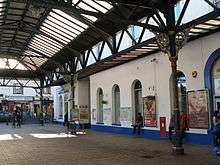
The passenger station was a three-storey building in an Italianate style, designed by David Mocatta in 1839–40 which incorporated the head office of the railway company. (This building still stands but has been largely obscured by later additions.) The station is said to have many similarities to the Nine Elms railway station of the London and Southampton Railway (1838) designed by Sir William Tite.[3] Baker & Son were paid £9766 15s for the station building between May and August 1841.[4] The platform accommodation was built by John Urpeth Rastrick and consisted of four pitched roofs each 250 ft long (76 m).[5] It opened for trains to Shoreham on 11 May 1840, and in September 1841 for trains to London.[6]
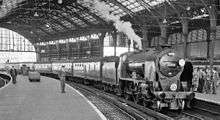
The station site was extended for the opening of the Brighton Lewes and Hastings Railway in June 1846 (which had been purchased by the L&BR in 1845). In July 1846, the L&BR merged with other railways to form the London, Brighton and South Coast Railway.
Further extensions to the station occurred during the mid-19th century but only a limited number of additional platforms could be added because of the awkward sloping site. By the late 1870s the facilities were inadequate for the growing volume of traffic and so the existing platforms were lengthened to be able to accommodate two trains, and the three separate roofs were replaced by an overall roof during 1882/1883.
The station currently has a large double-spanned curved glass and iron roof covering the platforms, which was substantially renovated in 1999 and 2000.[7]
At the front of the station is a taxi rank and a bus station. A tunnel runs under the station which once provided an open-air cab run at a shallower gradient than Trafalgar Street outside, which had been the main approach to the station before the construction of Queen's Road (which was financially supported by the railway, and intended to improve access). The cab run was covered (forming a tunnel) when the station above was extended over it on cast iron columns. The cab run remains in situ but has been sealed at the station end.
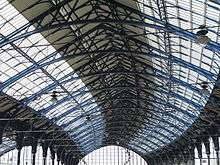
Goods station and yard
A goods station and yard was also constructed on the eastern side of the passenger station but on a site 30 ft lower (9.1 m) due to the sloping site, which was initially accessed from the Shoreham line by a second tunnel under the passenger station. The tunnel entrance was filled in after new tracks were laid into the goods yard, but a portion of it was converted into offices during World War II, and these were in use until the early 21st century. (A portion of the tunnel is still used by a local rifle club.) The site of the goods yard has since been redeveloped, and much of it forms the New England Quarter.
Locomotive and carriage works
To the north of the station, on the east side of the main line, the railway constructed its locomotive and carriage works, which operated from 1841 until 1911, when the carriage works was moved to Lancing and 1957 when the locomotive works closed. Thereafter Isetta cars were briefly built in a part of the works.
Locomotive depot
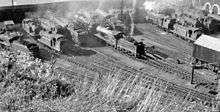
The London and Brighton Railway opened a small locomotive shed and servicing facility to the north west of the station for locomotives on the Shoreham line, in May 1840, and another, adjacent to the locomotive works for main line locomotives, the following year.[8] During 1860–1861 John Chester Craven, the Locomotive Superintendent of the London Brighton and South Coast Railway (LB&SCR) began the removal of a large chalk hill to the north of the station, which had been dumped during the excavation of the main line. The space created was used to accommodate a new much enlarged motive power depot in 1861, replacing the two existing facilities.[9][10] During the early 1930s, following the electrification of the lines the steam motive power depot was rebuilt and reduced in size.[9] It was closed 15 June 1961, but remained in use for stabling steam locomotives until 1964, and was demolished in 1966.

The site is currently the Network Rail's ECR and infrastructure maintenance depot, and Southern's Lovers Walk Depot, used for servicing most of Southern's single voltage Class 377 Electrostar fleet and their newly acquired Class 442s and Class 313s.
Listed status
Brighton station was listed at Grade II* on 30 April 1973.[11] As of February 2001, it was one of 70 Grade II*-listed buildings and structures, and 1,218 listed buildings of all grades, in the city of Brighton and Hove.[12]
Operating companies
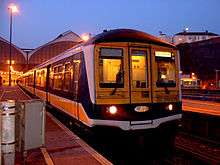
Trains are operated by franchises trading under the names:
Former operators

- London & Brighton Railway
- London, Brighton & South Coast Railway
- Southern Railway
- British Rail
- CrossCountry
- South West Trains
- Virgin Trains
- Connex South Central
- Wessex Trains
- Thameslink (original)
- First Capital Connect
Until 1967 a service operated between Brighton and Birkenhead Woodside via Redhill, Reading, Oxford, Birmingham Snow Hill, Wolverhampton Low Level, Shrewsbury and Chester. The stock was provided on alternate days by British Railways successors to the Southern Railway and the Great Western Railway being the Southern Region and Western Region.
Services
Currently, all trains are operated by Southern, Thameslink or Great Western Railway.
CrossCountry no longer operate from Brighton as of 14 December 2008 timetable change.
South West Trains also used to operate regular services from this station, to Reading and Paignton, via Worthing and Chichester. These services were withdrawn on 10 December 2007, due to new franchise obligations and South West Trains no longer operate any services from Brighton. This has caused some disruption to commuters as there are now no direct services from Brighton to Basingstoke and Winchester.
Typical hourly off-peak service pattern
| Preceding station | |
Following station | ||
|---|---|---|---|---|
| Terminus | Southern West Coastway |
Hove | ||
| Southern London-Brighton |
Preston Park or Hassocks or East Croydon | |||
| Southern East Coastway Stopping |
London Road | |||
| Southern East Coastway Fast |
Lewes | |||
| Terminus | Thameslink Bedford - Brighton |
Preston Park or Hassocks or Burgess Hill | ||
| Terminus | Great Western Railway Great Malvern / Worcester Shrub Hill – Brighton Peak Times Only |
Hove | ||
| Terminus | Southern Gatwick Express |
Gatwick Airport (Preston Park or Hassocks at peak times) | ||
| Disused railways | ||||
| Shoreham | British Rail Southern Region Steyning Line |
Terminus | ||
Brighton Main Line
The typical service from Brighton on the Brighton Main Line is:
- 2 tph (trains per hour) to London Victoria (semi-fast), operated by Southern;
- 2 tph to London Victoria calling only at Gatwick Airport, operated by Gatwick Express;
- 2 tph to Bedford via Gatwick Airport and London St Pancras (stopping), operated by Thameslink;
- 2 tph to London Bridge via Gatwick Airport (semi-fast), operated by Thameslink.
West Coastway Line
The typical service from Brighton on the West Coastway Line is:
- 2 tph to West Worthing (stopping), operated by Southern;
- 2 tph to Hove (to connect with semi-fast services from London Victoria to Littlehampton), operated by Southern;
- 1 tph to Portsmouth Harbour (semi-fast), operated by Southern;
- 1 tph to Southampton Central (semi-fast), operated by Southern.
There are also several trains per day to Bristol Temple Meads, some of which run further to Cardiff Central or Great Malvern. These services are operated by Great Western Railway.
East Coastway Line
The typical service from Brighton on the East Coastway Line is:
- 2 tph to Seaford via Lewes (stopping);
- 1 tph to Lewes only (stopping);
- 1 tph to Ore via Lewes, Eastbourne and Hastings (stopping);
- 1 tph to Ashford International via Lewes, Eastbourne, Hastings and Rye (fast).
All services on this line are operated by Southern.
Future services
Thameslink Programme
By 2018, new services from Brighton will be introduced to destinations north of central London (alongside the current services to Bedford).[13] In May 2014, a proposed timetable has been released; it is planned that:
- The current service between Brighton and London Bridge will be extended to Cambridge via London St Pancras, Stevenage and Letchworth Garden City;
- The current service between Brighton and Bedford will run via London Bridge (which at the moment they omit, as there are engineering works taking place at London Bridge, meaning that it is currently impossible to travel between London Bridge and London St Pancras directly).
In September 2016, a new proposed timetable has been released.[14] The planned service pattern from Brighton has remained largely unchanged, although Thameslink is also considering extending the Cambridge services to the new Cambridge North station.
Disruptions to services from the station
Football matches at the Falmer Stadium are served by train services from Brighton to Falmer. A queuing system is in operation from 2 hours before kick off for trains departing from platforms 7 and 8. The stadium's 30,750 capacity means these queues are large close to kick off, and trains depart full and standing. After the game, fans leave the station via the emergency gates, and a queuing system is in operation for West Coastway Line services departing from platforms 1 and 2. Due to the high numbers of passengers and inadequate capacity these trains are normally also full with people standing.
The Lewes Bonfire night, usually on 5 November, attracts large numbers of people, many travelling through Brighton station. As a result, Southern operate a queuing system from the afternoon onwards.[15]
The London to Brighton Bike Ride in June each year attracts large numbers of cyclists. As a result, Southern ban bicycles from many trains on the day, and on the following day they operate a queuing system at Brighton station.[16] The train operators had in the past allowed bicycles on trains for the many cyclists returning to London.[17]
Platform layout
The station has 8 platforms, numbered 1 to 8 from left to right when looking from the main entrance.
- Platform 1 can be used by services on the West Coastway Line only. It is usually served by trains to Hove, West Worthing and Southampton Central.
- Platform 2 can be used by services on the West Coastway Line. It is usually served by West Coastway Line trains to Hove, West Worthing and Portsmouth Harbour.
- Platform 3 can be used by services on the Brighton Main Line, West Coastway Line and the East Coastway Line. It is usually served by Brighton Main Line trains to London Victoria (semi-fast).
- Platform 4 can be used by services on the Brighton Main Line and the East Coastway Line. It is usually served by Brighton Main Line trains to London Victoria (express).
- Platform 5 can be used by services on the Brighton Main Line and the East Coastway Line. It is usually served by Brighton Main Line trains to Bedford.
- Platform 6 can be used by services on the Brighton Main Line and the East Coastway Line. It is usually served by Brighton Main Line trains to London Bridge.
- Platform 7 can be used by services on the Brighton Main Line and the East Coastway Line. It is usually served by East Coastway Line trains to Ashford International.
- Platform 8 can be used by services on the Brighton Main Line and the East Coastway Line. It is usually served by East Coastway Line trains to Lewes, Ore and Seaford.
All platforms are long enough to accommodate 12-car trains. However, the platform layout at the station does not always allow 12-car trains to call at platforms 2 and 3. Platform 2 has been built in the direction of the West Coastway Line, which means trains on that line can be up to 12 carriages long but the Brighton Main Line trains cannot have more than 4 carriages. Platform 3 has the exact opposite property: Brighton Main Line trains can be up to 12 carriages long but the West Coastway Line trains are limited to 4 carriages.
Facilities
Passenger facilities include a ticket office, a travel information office, and several retail outlets. There are bus stops, a taxi rank, a car park and bicycle storage. Facilities for cyclists were extended in 2014 when a "cycle hub" was built at the rear entrance to the station. The three-storey building combines storage space for 500 bicycles with shops to buy or hire a bicycle, a repair facility, toilets, showers, changing facilities and a café. It is open 24 hours a day and storage is free of charge; most funding came from the Department for Transport (£500,000), Network Rail (£200,000), local rail operator Southern and the city council (£100,000 each).[18]
Accidents
On 4 August 1909, a motor-train hauled by Terrier No.83 Earlswood collided with the buffers at Brighton, due to the driver's error. Nineteen people were injured.[19]
Concourse
In 2012 £4.5 million was secured from the Department for Transport’s Station Commercial Project Facility for renovation of the concourse. Changes include more automated ticket gates, a new travel and ticket centre, a new information booth, a new passenger lounge with cafe, relocation of the ticket machines and ATM's and changed layout of the station.[20]
The concourse includes a Marks & Spencer, WH Smiths, doodle, The Cyclist café bar, The Waiting room café and other food and retail outlets. The front of the station often sees stalls and street food vans.
Gallery
-

A Class 171 late night train to Ashford International covered in snow in the winter of 2009
-

The old departure board at the station
-

Virgin CrossCountry service to Manchester in 2006. This service was withdrawn in 2008, one year after Arriva started operating the CrossCountry franchise in 2007.
-
Trains at Brighton
- The station in 1961
-

June 1961 as 41300 backs onto 3 carriages to form train to Guildford via Horsham
-

LB&SCR "Terrier" steam engine British Railways No. 32635 Brighton Works in June 1961
-

The Brighton Belle electric train nears Brighton Station in June 1961
-

Class U1 31890 at Brighton in June 1961
-

Train for Lewes leaves Brighton Station June 1961
- The station in 1962
-

Station entrance
-

The concourse
-

View SE on towards the main station
See also
References
- ↑ Steer Davies Gleave (May 2013). "Estimates of station usage 2011–12" (XLSX). Office of Rail Regulation. Retrieved 19 May 2013.
- ↑ Turner, John Howard (1977). The London Brighton and South Coast Railway 1 Origins and Formation. Batsford. p. 123. ISBN 0-7134-0275-X.
- ↑ Cole, David (1958). "Mocatta's stations for the Brighton Railway". Journal of transport history. Manchester: Manchester University Press. 5: 149–157. ISSN 0022-5266.
- ↑ Cole (1958), pp.150.
- ↑ Cooper, B. K., (1981). 'Rail Centres: Brighton. Booklaw Publications. p. 30. ISBN 1-901945-11-1.
- ↑ Body, Geoffrey (1989). Railways of the Southern Region. Patrick Stephens. p. 53. ISBN 1-85260-297-X.
- ↑ Project information from Kier Construction Ltd
- ↑ Griffiths, Roger & Smith, Paul (1999). The directory of British engine sheds and principal locomotive servicing points: 1 Southern England, the Midlands, East Anglia and Wales. Oxford: Oxford Publishing Co. p. 3.
- 1 2 Cooper (1981), p. 58
- ↑ Griffiths (1999), p. 69
- ↑ "Detailed record: Brighton Station including train sheds, Queen's Road (north side), Brighton". Images of England. English Heritage. 2007. Retrieved 31 January 2010.
- ↑ "Images of England – Statistics by County (East Sussex)". Images of England. English Heritage. 2007. Archived from the original on 27 December 2012. Retrieved 27 December 2012.
- ↑ Proposed Thameslink service pattern
- ↑ Timetable consultation : Thameslink and Great Northern
- ↑ "Lewes Bonfire Night". Retrieved 13 June 2013.
- ↑ "London to Brighton Bike Ride Southern Cycle Policy". Archived from the original on 29 November 2010. Retrieved 13 June 2013.
- ↑ "Cyclists' group urges rethink on London to Brighton Bike Ride train ban". Brighton & Hove News. 12 June 2012. Retrieved 13 June 2013.
- ↑ "Station cycle centre on course for completion". Brighton & Hove Independent. Love News Media Ltd. 6 June 2014. p. 5.
- ↑ Middlemass, Tom (1995). "Chapter 5: A Complicated Tale". Stroudley and his Terriers. York: Pendragon. p. 51. ISBN 1-899816-00-3.
Earlswood hit the platform buffers
- ↑
Further reading
- "£18m rebuild of Brighton station starts with £3m working platform". RAIL. No. 323. EMAP Apex Publications. 28 January – 10 February 1998. p. 14. ISSN 0953-4563. OCLC 49953699.
External links
| Wikimedia Commons has media related to Brighton railway station. |
- Pages from My Brighton and Hove
- Kent Rail's page on Brighton station
- YouTube video of trains arriving/departing in 1995
- Brighton Station
- Brighton Station page at Southern Railway

